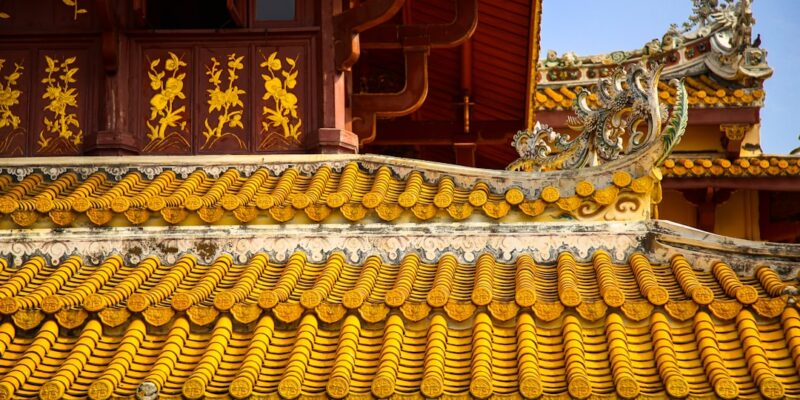
Discovering Angkor Wat’s Ancient Temples
Angkor Wat, located in Siem Reap, Cambodia, is one of the most iconic and important archaeological sites in Southeast Asia. It is a massive temple complex that was built during the Khmer Empire, which ruled over much of present-day Cambodia from the 9th to the 15th centuries. Angkor Wat is not only a testament to the architectural and engineering prowess of the Khmer people, but it also holds great significance in Southeast Asian history and culture.
The temple complex of Angkor Wat covers an area of over 400 acres and is surrounded by a moat that stretches for 3.6 kilometers. It is the largest religious monument in the world and is considered a masterpiece of Khmer architecture. The temples were originally built as Hindu temples dedicated to the god Vishnu, but later became Buddhist temples. Today, Angkor Wat is a UNESCO World Heritage site and attracts millions of visitors from around the world each year.
Key Takeaways
- Angkor Wat is a complex of ancient temples in Cambodia that is a UNESCO World Heritage Site.
- The temples were built in the 12th century by the Khmer Empire and are dedicated to the Hindu god Vishnu.
- The architecture of Angkor Wat’s temple complex is characterized by intricate carvings, towering spires, and expansive courtyards.
- Visitors can explore the main temples of Angkor Wat, including the iconic Angkor Wat temple, the Bayon temple, and the Ta Prohm temple.
- The temples are surrounded by mysteries and legends, including stories of hidden treasure and supernatural beings.
The History and Origins of Angkor Wat
The origins of Angkor Wat can be traced back to the Khmer Empire, which was one of the most powerful empires in Southeast Asia during its time. The empire was founded by Jayavarman II in 802 AD and reached its peak under King Suryavarman II in the 12th century. It was during this time that Angkor Wat was built as a state temple and capital city.
Angkor Wat was constructed between the 9th and 12th centuries and served as a symbol of the power and wealth of the Khmer Empire. The temple complex was designed to represent Mount Meru, which is considered to be the center of the universe in Hindu mythology. The construction of Angkor Wat required an enormous amount of resources and labor, with estimates suggesting that it took around 30 years and thousands of workers to complete.
The historical significance of Angkor Wat’s temples lies in their role as a center of political, religious, and cultural life during the Khmer Empire. The temples were not only places of worship, but also served as administrative and educational centers. They were adorned with intricate carvings and sculptures that depicted scenes from Hindu mythology and the lives of the Khmer people. The temples also housed important religious artifacts and were the site of important ceremonies and rituals.
The Architecture of Angkor Wat’s Temple Complex
The architecture of Angkor Wat’s temple complex is a testament to the ingenuity and skill of the Khmer people. The temples are built in a unique architectural style known as Khmer architecture, which combines elements of Hinduism and Buddhism with local traditions.
The most distinctive feature of Angkor Wat’s temples is their towering spires, known as prasats, which are designed to resemble the mythical Mount Meru. The temples are built on multiple levels, with each level representing a different realm in Hindu cosmology. The outer walls of the temples are adorned with intricate bas-reliefs that depict scenes from Hindu mythology and historical events.
Another unique feature of Angkor Wat’s temples is their use of sandstone, which was quarried from nearby mountains. The sandstone was carefully carved and shaped to create the intricate carvings and sculptures that adorn the temples. The use of sandstone not only gave the temples their distinctive appearance, but also helped to preserve them over the centuries.
Exploring the Main Temples of Angkor Wat
| Temple Name | Year Built | Size (m²) | Number of Towers | Number of Bas-Reliefs |
|---|---|---|---|---|
| Angkor Wat | 12th century | 162.6 hectares | 5 | 1,200 |
| Bayon Temple | 13th century | 11,000 m² | 37 | 11,000 |
| Ta Prohm | 12th century | 39,000 m² | 5 | 12,500 |
| Banteay Srei | 10th century | 9,000 m² | 4 | 2,200 |
The temple complex of Angkor Wat is home to several main temples, each with its own unique features and significance. One of the most famous temples is Angkor Wat itself, which is considered the masterpiece of Khmer architecture. It is a massive temple with five towers that rise above the surrounding landscape. The temple is surrounded by a series of galleries that are adorned with intricate carvings and sculptures.
Another important temple in the complex is Bayon, which is known for its massive stone faces that adorn its towers. The faces are believed to represent the bodhisattva Avalokiteshvara, who is considered the embodiment of compassion in Buddhism. The temple is also known for its bas-reliefs, which depict scenes from everyday life in the Khmer Empire.
Ta Prohm is another popular temple in the complex, known for its atmospheric setting and its intertwining trees that have grown over the ruins. The temple was left largely untouched during the restoration efforts and provides a glimpse into what the temples would have looked like when they were first discovered.
The Mysteries and Legends Surrounding Angkor Wat
Angkor Wat’s temples are shrouded in mystery and legends that have been passed down through generations. One of the most famous legends is that of the “Lost City of Angkor,” which suggests that there are hidden chambers and treasures buried beneath the temples. While there is no concrete evidence to support this claim, it has captured the imagination of many and adds to the allure of Angkor Wat.
There are also unexplained mysteries surrounding Angkor Wat’s temples, such as how they were constructed with such precision and without the use of modern technology. The sheer scale and complexity of the temples have led some to speculate that they were built with the help of extraterrestrial beings or advanced ancient civilizations.
The Restoration and Preservation of Angkor Wat’s Temples
Efforts to restore and preserve Angkor Wat’s temples began in the early 20th century, when French archaeologists first started exploring the site. Since then, numerous restoration projects have been undertaken to repair damage caused by natural disasters, looting, and the passage of time.
The restoration efforts have faced many challenges, including limited funding, lack of skilled labor, and the need to balance preservation with tourism. The temples are delicate structures that require constant maintenance and care to prevent further deterioration. Additionally, the influx of tourists has put a strain on the temples, with some areas being closed off to visitors to prevent further damage.
Despite these challenges, the restoration efforts have been largely successful in preserving the temples and ensuring their longevity. Today, Angkor Wat’s temples are carefully monitored and maintained by a team of experts who work tirelessly to protect them for future generations.
The Role of Angkor Wat in Cambodian Culture and Religion
Angkor Wat holds great importance in Cambodian culture and religion. It is considered a national symbol and is featured on the country’s flag and currency. The temples are also an important pilgrimage site for Buddhists, who come from all over Cambodia and Southeast Asia to pay their respects.
The temples are used for religious ceremonies and festivals throughout the year, with thousands of people gathering to celebrate important Buddhist holidays. The temples also serve as a place of meditation and reflection for monks and devotees.
The Impact of Tourism on Angkor Wat’s Temples
The tourism industry has had both positive and negative effects on Angkor Wat’s temples. On one hand, tourism has brought much-needed revenue to the local economy and has helped to fund restoration projects and infrastructure development. It has also provided employment opportunities for local communities.
On the other hand, the influx of tourists has put a strain on the temples and has led to issues such as overcrowding, vandalism, and theft. The constant flow of visitors has also caused wear and tear on the structures, leading to the need for ongoing maintenance and repairs.
Efforts have been made to manage tourism and preserve the temples. This includes implementing visitor limits, enforcing strict rules on behavior within the temple complex, and investing in infrastructure improvements to accommodate the growing number of visitors.
The Future of Angkor Wat’s Ancient Temples
The preservation of Angkor Wat’s temples faces many challenges, including climate change, natural disasters, and the passage of time. The temples are vulnerable to erosion, flooding, and structural instability, which can cause irreparable damage.
To ensure the future of the temples, there are plans to continue restoration efforts and invest in research and monitoring. This includes using advanced technology to study the temples and develop strategies for their long-term preservation.
Tips for Visiting Angkor Wat’s Temples and Making the Most of Your Experience
If you are planning a visit to Angkor Wat’s temples, here are some practical tips to help you make the most of your experience:
1. Plan your visit in advance: The temple complex is vast, so it’s important to plan your visit in advance to make sure you see all the main temples. Consider hiring a guide or joining a tour to get the most out of your visit.
2. Dress appropriately: The temples are sacred sites, so it’s important to dress respectfully. Wear clothing that covers your shoulders and knees, and avoid wearing hats or sunglasses inside the temples.
3. Bring plenty of water and sunscreen: The temple complex can get hot and humid, so it’s important to stay hydrated and protect yourself from the sun. Bring a refillable water bottle and apply sunscreen regularly.
4. Be respectful: Remember that the temples are still active religious sites, so it’s important to be respectful of the local customs and traditions. Avoid touching or climbing on the temple structures, and be mindful of your behavior.
5. Take your time: The temple complex is vast and there is a lot to see, so take your time to explore and soak in the atmosphere. Don’t rush from one temple to another; instead, take the time to appreciate the intricate carvings and sculptures.
By following these tips, you can have a memorable and meaningful experience visiting Angkor Wat’s ancient temples.
FAQs
What is Angkor Wat?
Angkor Wat is a temple complex located in Cambodia, built during the Khmer Empire in the 12th century.
What are the other temples in Angkor Wat?
Apart from Angkor Wat, there are several other temples in the Angkor Archaeological Park, including Bayon, Ta Prohm, Banteay Srei, and Preah Khan.
What is the best time to visit Angkor Wat?
The best time to visit Angkor Wat is during the dry season, which runs from November to March. The weather is cooler and there is less chance of rain.
What is the dress code for visiting Angkor Wat?
Visitors are required to dress modestly when visiting Angkor Wat. This means covering shoulders and knees, and avoiding revealing clothing.
How long does it take to explore Angkor Wat?
It can take anywhere from one day to several days to explore Angkor Wat and the surrounding temples, depending on how much time you have and how much you want to see.
Is it safe to visit Angkor Wat?
Yes, it is generally safe to visit Angkor Wat. However, visitors should take precautions against pickpocketing and be aware of their surroundings.
What is the entrance fee for Angkor Wat?
The entrance fee for Angkor Wat varies depending on the length of your visit. A one-day pass costs $37, a three-day pass costs $62, and a seven-day pass costs $72.


















